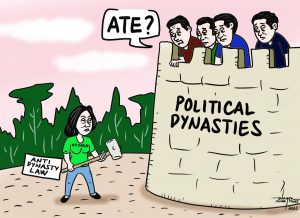In our last column we wrote about the apparent “flexibility” of the Davao City Council when it comes to approving development projects initiated by big private businesses. Our item was based on the body’s approval of the application by a leading housing subdivision developer to carve out a huge portion of the iconic Shrine Hills for the putting up of a high-end residential enclave.
In fact from the reaction of the leading environmentalist group Interfacing Development Initiatives (IDIs) and residents of Maa living at the foot of the hills it appears that they knew only of the plan housing subdivision after the developer posted on social media that it has already broke ground for the project.
Simply put the developer has already gotten the approval of the Sanggunian because it could not have done the ground breaking if the imprimatur was not acquired. We assume that there were hearings conducted on the development application despite the fact that we haven’t heard of any.
The environmentalist group in its reaction questioned the SP’s approval of the subdivision development claiming that under the City’s Zoning Ordinance the putting up of subdivisions on the slopes of Shrine Hills is strongly restricted for the simple reason that a Department of Environment and Natural Resources (DENR) study conducted on the soil composition of the hills, showed it is highly susceptible to massive erosion. Therefore interfering with the contour of Shrine Hills would pose a serious threat to the safety of residents in Maa and portions of Matina.
The Sanggunian’s approval of the housing subdivision development in that portion of Shrine Hills reminded us of one laudable action of the City’s previous Sanggunian some years back. And that was the stoppage of the development of a residential subdivision also on the slopes of Shrine Hills done by a property developer firm owned by former Senate President Manny Villar. It was quite a bold move considering that there were already initial road constructions done on the controverted site.
We remember how that particular rejection by the Council of the housing subdivision project was lauded by environment advocates and residents at the foot of the hills directly below the planned development area.
The same IDIS reaction to the high-end housing project that broke ground recently leads us to surface our observation of the various residential subdivision projects now being developed on the slopes of Barangay Magtuod going to New Carmen and New Valencia in the city’s third district.
Shortly before and after the Magtuod Barangay Hall the slopes on both sides of the barangay road are cleared of trees and bulldozed to give way to subdivision road construction. One subdivision is overlooking the Tigatto-Buhangfin area, and about half of the city proper. The two land developments on the other side are facing the remaining greens of Barangay Langub Excess water and soil erosion once the development is completed on both sides go directly to Davao River and the creek leading to a small lake fronting the GAP Farm in Maa, with the latter water overflows likely to inundate the CP Garcia Diversion Highway leading to NHA subdivision down further to Maa proper.
And if we are to believe some enterprising dicers and sales agents, a large area in a valley nestled by the hills of Barangays Langub, New Carmen and Biao Matina is now being developed into another privately-owned memorial park or burial ground. In fact some friends have advised us to join their ranks as “early birds” among those who have made reservations for graveyard sites.
That these projects are developments in the city that can bring new money to the treasury is inarguable. And certainly this could be the main motivation of the Davao City Council to approve the application of the developers of such projects.
However, the public should take note that the areas where these developments are introduced are critical to another obsession of the local government. That is, that the city will have the kind of environment and ecology that are ideal to live for the longest time – eternally if possible.
So what then do these projects do with the efforts of the local government of the city to attain its desire to become one among the most livable cities in the country? What is the use of making city residents foot the bills for ecological services as per proposed ordinance by a lady councilor when at the same time the council continues to be ambivalent with its policy like allowing sites critical to environment protection destroyed by the so-called development strides?
Imagine allowing the conversion of large tracts of agricultural land by big-time property developers into residential and/or commercial enclaves so their businesses could further expand! So aggressive are these developers and equally resilient are the members of the City Council to the importuning of the mighty businessmen that they seem oblivious to the negative consequences of their actions.
Now it becomes clear to many why the Council always put provisions on certain ordinances like the Zoning Ordinance or the Comprehensive Land Use policy allowing for amendments to accommodate “favored” applicants for locational clearance. So flexible are some ordinances, specifically those related to real property development that even watershed, top of aquifers, agricultural and forest areas are fair game to land use amendment – all in the name of progress.



